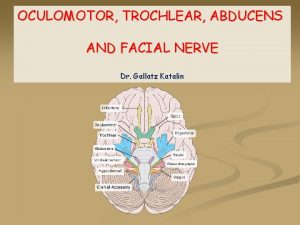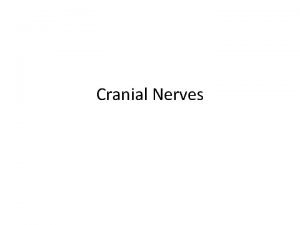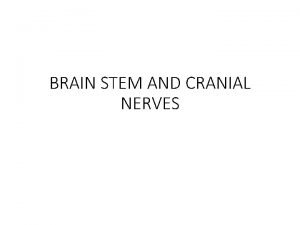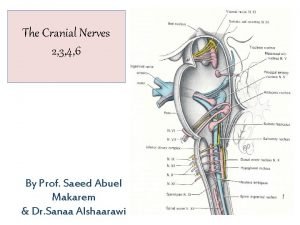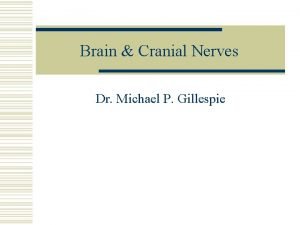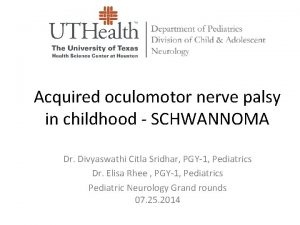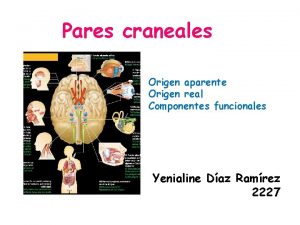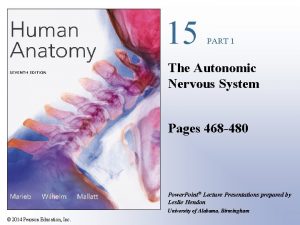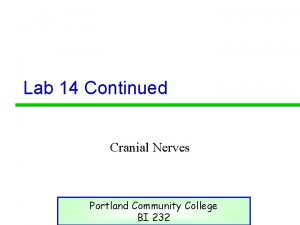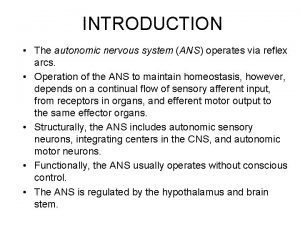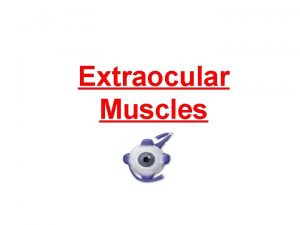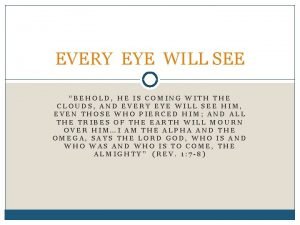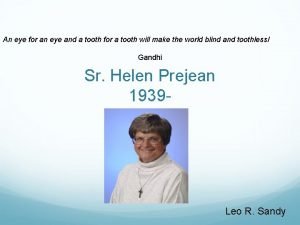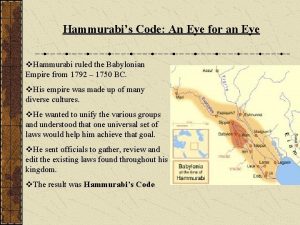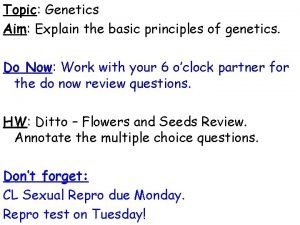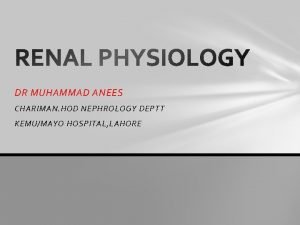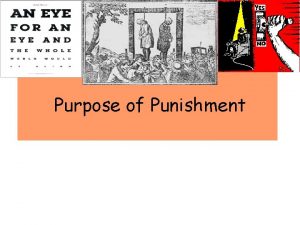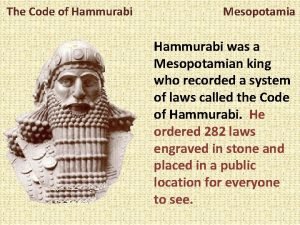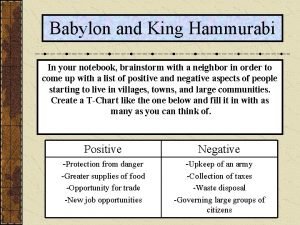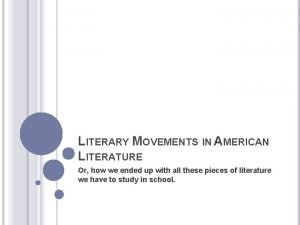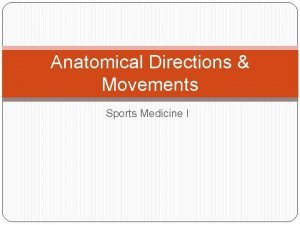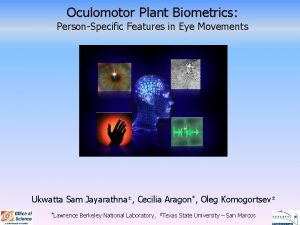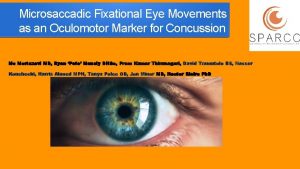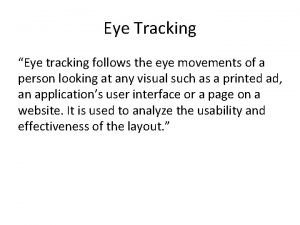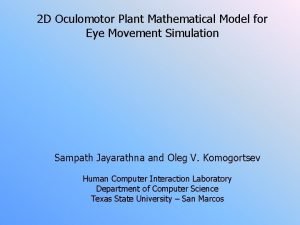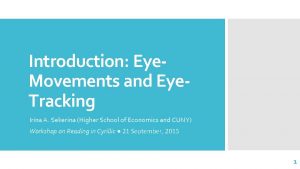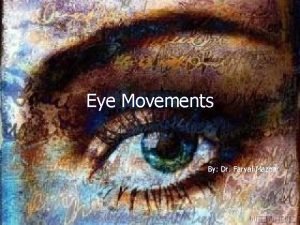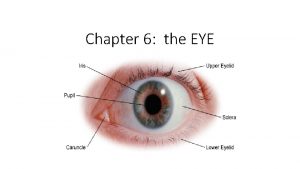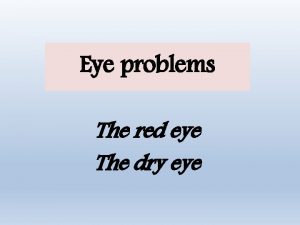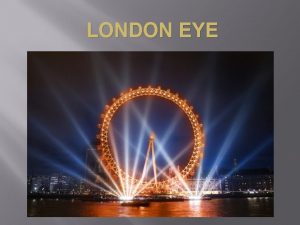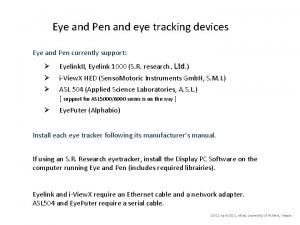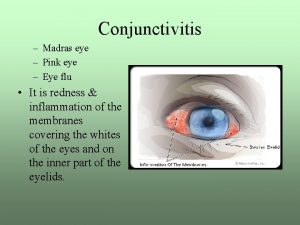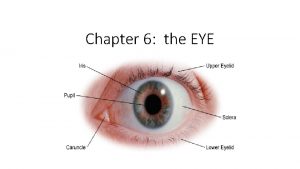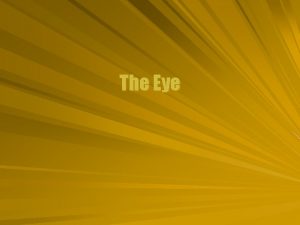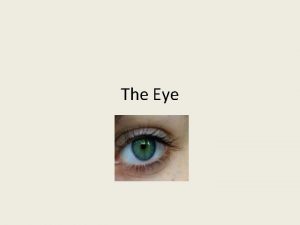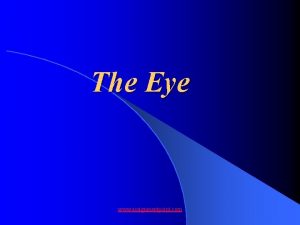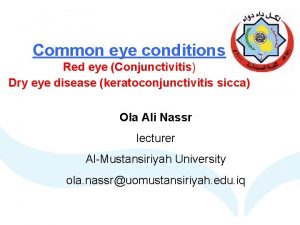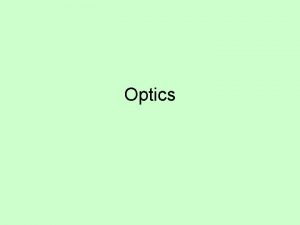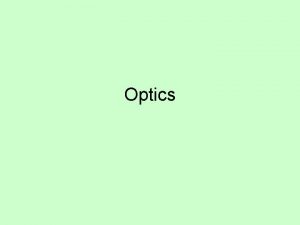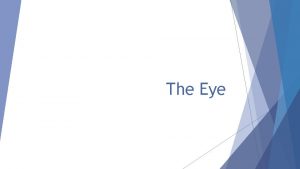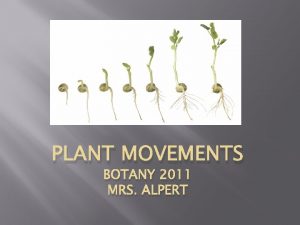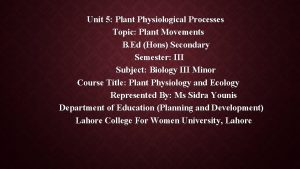Eye Movements 1 The Plant The Oculomotor Plant











































































- Slides: 75

Eye Movements

1. The Plant

The Oculomotor Plant Consists Of only 6 muscles in 3 pairs

This Yields 3 degrees of Mechanical Freedom

Donder’s Law/ Listing’s Law Neural Constraints Reduce this to 2 degrees of freedom

3 -D eye movements • Donder’s Law – Relates torsion to eye position • Listing’s law – Torsion results from rotation of eye around perpendicular axis • Listing’s plane – Plane orthogonal to line of sight • Does not apply when head is free

Kinematics vs Dynamics In the Oculomotor System Rotations about the Center of Gravity No Loads No Inertia Force = Position

Oculomotor muscles and nerves • Oculomotor nerve (III) – Medial rectus – Superior/Inferior recti – Inferior oblique • Trochlear nerve (IV) – Superior oblique • Abducens nerve (VI) – Lateral rectus • Medial longitudinal fasciculus

2. The Behaviors Gaze Holding: VOR OKN Gaze Shifting: Saccades Vergence Smooth Pursuit

Classes of eye movements • Reflexive – gaze stabilization – VOR • Stabilize for head movements – Optokinetic • Stabilize for image motion • Voluntary – gaze shifting – Saccades • Acquire stationary target – Smooth pursuit • Acquire moving target – Vergence • Acquire target in depth

Gaze During Nystagmus

Saccades


3 -D Gaze Trajectory Vergence


2. The Motor Neurons

Force Patterns Robinson’s Lollipop Experiments Statics Dynamics

Oculomotor Neurons During Static Gaze

Dynamics and Statics


3. VOR






Cupula and otoliths move sensory receptors Cristae Maculae



Angular Acceleration Angular Velocity Angular Position Cupula Deflection

Canal afferents code velocity • Spontaneous activity allows for bidirectional signaling • S-curve is common • Different cells have different ranges and different dynamics • Population code

Canal Output During Slow Sinusoidal Rotation

VOR With and Without Vision

r. VOR gain varies with frequency • Almost perfect > 1 Hz • Low gain for low frequencies (0. 1 Hz) • Sensory mechanisms can compensate (optokinetic reflex)


Oculomotor muscles and nerves • Oculomotor nerve (III) – Medial rectus – Superior/Inferior recti – Inferior oblique • Trochlear nerve (IV) – Superior oblique • Abducens nerve (VI) – Lateral rectus

The 3 -Neuron Arc Primary Effects of Canals on Eye Muscles Canal Excites Inhibits Horizontal Ipsi MR, Contra LR Ipsi LR, Contra MR Anterior Ipsi SR, Contra IO Ipsi IR, Contra SO Posterior Ipsi SO, Contra IR Ipsi IO, Contra SR

Robinson’s Model of the VOR

Robinson

4. OKN

Type I Vestib Neuron

Bode Plot of OKN


Bode Plot of VOR

Bode Plot of OKN

5. Saccades





Saccadic system

OPN Stimulation

Brainstem saccadic control • Paramedian pontine reticular formation (PPRF) – – – Burst and omnipause neurons Aim to reduce horizontal motor error Project to directly to lateral rectus motor neurons Projects indirectly to contralateral medial rectus Medial longitudinal fasciculus • Mesencephalic reticular formation – Also influenced by omnipause neurons – Vertical motor error – Projects to superior and inferior rectus motor neurons




Robinson’s Model of the VOR


Lee, Rohrer and Sparks

Jay and Sparks



5. Pursuit


Smooth pursuit • Track movement on part of retina • Two theories – Motor (Robinson) • Retinal slip only provides velocity • Does not capture pursuit onset – Sensory (Lisberger and Krauzlis) • Position, velocity and acceleration

Smooth pursuit system

Smooth pursuit brainstem • Eye velocity for pursuit medial vestibular nucleus and nucleus prepositus hypoglossi – Project to abducens and oculomotor nuclei – Input from flocculus of cerebellum encodes velocity • PPRF also encodes velocity – Input from vermis of cerebellum encodes velocity • Dorsolateral pontine nucleus – Relays inputs from cortex to cerebellum and oculomotor brainstem

Smooth pursuit cortex • Visual motion areas MT and MST – Active in visual processing for pursuit – Stimulation influences pursuit speed – Projects to DLPN and FEF – Does not initiate pursuit • Frontal eye fields – Stimulation initiates pursuit – Lesions diminish pursuit





Jergens

Scudder

 Examples of axial movement
Examples of axial movement Site:slidetodoc.com
Site:slidetodoc.com Oculomotor
Oculomotor Oculomotor nerve
Oculomotor nerve Oculomotor nerve
Oculomotor nerve Cranial nerve 4 function
Cranial nerve 4 function Oculomotor nerve
Oculomotor nerve Origen real y aparente de los nervios craneales
Origen real y aparente de los nervios craneales Oculomotor nerve
Oculomotor nerve Oculomotor nerve
Oculomotor nerve Hypoglossal nerve function test
Hypoglossal nerve function test Ans
Ans Cranial nerve 9
Cranial nerve 9 Medial movement of eye
Medial movement of eye Oculocephalic
Oculocephalic 2 types of physical fitness
2 types of physical fitness Behold he is coming
Behold he is coming Birds eye view worms eye view
Birds eye view worms eye view An eye for an eye a tooth for a tooth sister act
An eye for an eye a tooth for a tooth sister act An eye for an eye hammurabi
An eye for an eye hammurabi Explain
Explain Dr anees nephrologist
Dr anees nephrologist An eye for an eye meaning
An eye for an eye meaning Hammurabi
Hammurabi Hammurabi's code activity
Hammurabi's code activity Tronsmo plant pathology and plant diseases download
Tronsmo plant pathology and plant diseases download Plant introduction
Plant introduction Tronsmo plant pathology and plant diseases download
Tronsmo plant pathology and plant diseases download Plant breeding for disease resistance
Plant breeding for disease resistance Tronsmo plant pathology and plant diseases download
Tronsmo plant pathology and plant diseases download Plant introduction in plant breeding
Plant introduction in plant breeding Vẽ hình chiếu vuông góc của vật thể sau
Vẽ hình chiếu vuông góc của vật thể sau Công thức tiính động năng
Công thức tiính động năng Tỉ lệ cơ thể trẻ em
Tỉ lệ cơ thể trẻ em Thế nào là mạng điện lắp đặt kiểu nổi
Thế nào là mạng điện lắp đặt kiểu nổi Lời thề hippocrates
Lời thề hippocrates Vẽ hình chiếu đứng bằng cạnh của vật thể
Vẽ hình chiếu đứng bằng cạnh của vật thể Quá trình desamine hóa có thể tạo ra
Quá trình desamine hóa có thể tạo ra Các môn thể thao bắt đầu bằng tiếng đua
Các môn thể thao bắt đầu bằng tiếng đua Hình ảnh bộ gõ cơ thể búng tay
Hình ảnh bộ gõ cơ thể búng tay Sự nuôi và dạy con của hươu
Sự nuôi và dạy con của hươu điện thế nghỉ
điện thế nghỉ Dạng đột biến một nhiễm là
Dạng đột biến một nhiễm là Biện pháp chống mỏi cơ
Biện pháp chống mỏi cơ Phản ứng thế ankan
Phản ứng thế ankan Trời xanh đây là của chúng ta thể thơ
Trời xanh đây là của chúng ta thể thơ Voi kéo gỗ như thế nào
Voi kéo gỗ như thế nào Thiếu nhi thế giới liên hoan
Thiếu nhi thế giới liên hoan Vẽ hình chiếu vuông góc của vật thể sau
Vẽ hình chiếu vuông góc của vật thể sau Một số thể thơ truyền thống
Một số thể thơ truyền thống Thế nào là hệ số cao nhất
Thế nào là hệ số cao nhất Ng-html
Ng-html Sơ đồ cơ thể người
Sơ đồ cơ thể người Số.nguyên tố
Số.nguyên tố đặc điểm cơ thể của người tối cổ
đặc điểm cơ thể của người tối cổ Các châu lục và đại dương trên thế giới
Các châu lục và đại dương trên thế giới Cách giải mật thư tọa độ
Cách giải mật thư tọa độ Tư thế worm breton là gì
Tư thế worm breton là gì ưu thế lai là gì
ưu thế lai là gì Tư thế ngồi viết
Tư thế ngồi viết Thẻ vin
Thẻ vin Bàn tay mà dây bẩn
Bàn tay mà dây bẩn Các châu lục và đại dương trên thế giới
Các châu lục và đại dương trên thế giới Bổ thể
Bổ thể Từ ngữ thể hiện lòng nhân hậu
Từ ngữ thể hiện lòng nhân hậu Tư thế ngồi viết
Tư thế ngồi viết Giọng cùng tên là
Giọng cùng tên là 101012 bằng
101012 bằng Thơ thất ngôn tứ tuyệt đường luật
Thơ thất ngôn tứ tuyệt đường luật Alleluia hat len nguoi oi
Alleluia hat len nguoi oi Khi nào hổ mẹ dạy hổ con săn mồi
Khi nào hổ mẹ dạy hổ con săn mồi Diễn thế sinh thái là
Diễn thế sinh thái là đại từ thay thế
đại từ thay thế Literary movements in america
Literary movements in america African independence movements
African independence movements Angular movement
Angular movement

